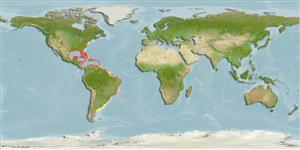Classification / Names
Common names from other countries
Main reference
Size / Weight / Age
Max length : 33.0 cm TL male/unsexed; (Ref. 7251); common length : 20.0 cm TL male/unsexed; (Ref. 9626); max. published weight: 550.00 g (Ref. 9626); max. reported age: 2 years (Ref. 3422)
Length at first maturity
Lm 8.0 range ? - ? cm
Environment
Marine; brackish; reef-associated
Climate / Range
Subtropical; 22°C - 34°C, preferred 25°C (Ref. 107945); 41°N - 58°S, 98°W - 34°W
Distribution
Short description
Dorsal
spines
(total): 13;
Dorsal
soft rays
(total): 10-11;
Anal
spines: 3;
Anal
soft rays: 10 - 11. Large intestine makes up 90% of digestive tract and is twice the standard length, on the average; the stomach with 7 digestive caeca attached near the pyloric region. Pelvic fin coloration totally or partially dark in males; orange colored in females. Large dark spot (about same size as eye) below lateral line just behind gill opening (Ref. 26938).
IUCN Red List Status (Ref. 115185)
Threat to humans
Harmless
Human uses
Fisheries: commercial
More information
ReferencesAquacultureAquaculture profileStrainsGeneticsAllele frequenciesHeritabilityDiseasesProcessingMass conversion
Tools
Special reports
Download XML
Internet sources
Estimates of some properties based on models
Phylogenetic diversity index
PD50 = 0.6250 many relatives (e.g. carps) 0.5 - 2.0 few relatives (e.g. lungfishes)
Trophic Level
2.9 ±0.1 se; Based on diet studies.
Resilience
High, minimum population doubling time less than 15 months (K=1.27; tm=0.4; tmax=2)
Vulnerability
Moderate vulnerability (37 of 100)
Price category
